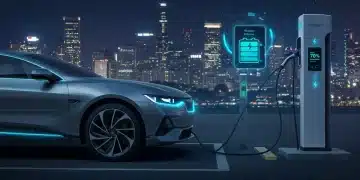Next-Gen Batteries: 5 Breakthroughs for 50% Longer Lifespans by 2027

Next-gen battery breakthroughs are set to extend the lifespan of US consumer electronics by 50% by 2027, promising a significant shift in device longevity and user experience through advanced materials and designs.
The quest for longer-lasting, more efficient power sources is a relentless pursuit in the world of consumer electronics. Imagine your smartphone lasting not just a day, but several, or your laptop maintaining peak performance for years without battery degradation. This vision is rapidly becoming a reality, as significant advancements in next-gen battery breakthroughs are poised to deliver a remarkable 50% longer lifespan in US consumer electronics by 2027.
The urgent demand for enhanced battery performance
In our increasingly connected world, consumer electronics are integral to daily life. From smartphones and smartwatches to laptops and electric vehicles, these devices power our communication, work, entertainment, and transportation. However, a persistent challenge has been the limited lifespan and capacity of conventional lithium-ion batteries, often dictating the upgrade cycle of our beloved gadgets. This limitation not only impacts user experience but also contributes to electronic waste, posing a significant environmental concern.
The demand for batteries that can keep pace with technological advancements is greater than ever. Consumers expect devices that last longer, charge faster, and maintain their performance over extended periods. This expectation drives intense research and development efforts across the globe, focusing on innovative materials and architectural designs to push the boundaries of energy storage. The goal is clear: to create batteries that are not only more powerful but also safer, more sustainable, and ultimately, more reliable for the long haul.
Addressing this demand requires a multi-faceted approach, encompassing everything from fundamental material science to advanced manufacturing techniques. The breakthroughs we are witnessing today are the culmination of decades of research, fueled by both academic curiosity and industrial necessity. These innovations promise to redefine our relationship with electronic devices, making them more durable and less disposable. The implications extend far beyond individual gadgets, potentially impacting infrastructure, energy grids, and even space exploration.
The environmental and economic impact of battery degradation
- Electronic Waste (E-waste): Short battery lifespans contribute significantly to the growing global problem of e-waste, which contains hazardous materials.
- Resource Depletion: The continuous production of new batteries consumes finite resources, necessitating more sustainable alternatives.
- Consumer Costs: Frequent device replacement due to battery degradation places an economic burden on consumers.
- Performance Decline: Degraded batteries lead to slower device performance, frustrating users and shortening device utility.
The imperative for better batteries is not just about convenience; it’s about sustainability and economic viability. By extending battery lifespans, we can reduce waste, conserve resources, and provide greater value to consumers, aligning technological progress with environmental responsibility. This holistic view underscores the importance of the innovations we are about to explore.
Solid-state batteries: a paradigm shift in safety and density
One of the most anticipated and transformative advancements in battery technology is the emergence of solid-state batteries. Unlike traditional lithium-ion batteries that rely on flammable liquid electrolytes, solid-state batteries utilize a solid material to conduct ions between the anode and cathode. This fundamental change offers a host of benefits, most notably enhanced safety and significantly higher energy density, paving the way for truly revolutionary electronic devices.
The elimination of liquid electrolytes drastically reduces the risk of thermal runaway and fires, which have been a concern with conventional lithium-ion batteries. This inherent safety advantage makes solid-state batteries ideal for a wide range of applications, from consumer electronics where safety is paramount, to electric vehicles where high power and reliability are crucial. Beyond safety, solid electrolytes can enable the use of lithium metal anodes, which boast a much higher theoretical energy capacity than the graphite anodes currently used, leading to smaller, lighter, and more powerful batteries.
While still facing manufacturing challenges, such as achieving good contact between solid interfaces and managing volume changes during charging and discharging, rapid progress is being made. Companies and research institutions are investing heavily in developing scalable production methods and optimizing solid electrolyte materials. The potential rewards are immense, promising a future where our devices not only last longer but are also inherently safer to use and transport.
Key benefits of solid-state technology
- Enhanced Safety: Eliminates flammable liquid electrolytes, significantly reducing fire risk.
- Higher Energy Density: Allows for more energy to be stored in a smaller, lighter package.
- Longer Lifespan: Improved cycle stability and reduced degradation over time.
- Faster Charging: Potential for quicker charge times due to efficient ion transport.
Solid-state batteries represent a critical step towards overcoming the limitations of current battery technology. Their development is not just an incremental improvement but a fundamental change that could reshape the entire landscape of portable power, making devices more robust and reliable for consumers.
Silicon anode advancements: boosting capacity and cycle life
The anode material plays a crucial role in determining a battery’s energy density and overall performance. For decades, graphite has been the standard material for lithium-ion battery anodes. However, researchers are increasingly turning their attention to silicon, which holds the promise of vastly superior energy storage capabilities. Silicon can store significantly more lithium ions per unit volume than graphite, theoretically leading to batteries with up to ten times the energy density.
The challenge with silicon anodes has traditionally been their tendency to expand and contract dramatically during charging and discharging cycles. This volume change can lead to mechanical stress, cracking, and ultimately, rapid degradation of the battery’s performance and lifespan. However, recent breakthroughs have focused on engineering silicon at the nanoscale, creating structures that can better accommodate these volume fluctuations without compromising structural integrity. This includes the development of silicon nanoparticles, nanowires, and porous silicon architectures.
These innovations mitigate the expansion issues, allowing silicon anodes to maintain their high capacity over many charge cycles. The integration of silicon into existing battery manufacturing processes is also becoming more feasible, with some companies already incorporating small percentages of silicon into their anodes to achieve incremental gains. As research progresses, we can expect to see higher percentages of silicon, leading to increasingly powerful and long-lasting batteries that directly translate to extended usage times for consumer electronics.
![]()
The ability to harness silicon’s immense energy storage potential is a game-changer for battery technology. By overcoming its inherent instability, scientists are unlocking a new era of high-capacity batteries that will significantly enhance the performance and longevity of our electronic devices, making them more efficient and user-friendly.
Lithium-sulfur batteries: high energy, lower cost potential
Another promising contender in the race for next-generation batteries is lithium-sulfur (Li-S) technology. Li-S batteries offer a theoretical energy density that is several times higher than current lithium-ion batteries, primarily due to the high specific capacity of sulfur. Sulfur is also an abundant and inexpensive material, making Li-S batteries an attractive option for reducing manufacturing costs and improving sustainability.
The main hurdles for Li-S batteries have been their relatively poor cycle life and the problem of polysulfide shuttle, where intermediate reaction products dissolve into the electrolyte and migrate to the anode, leading to irreversible loss of active material and rapid capacity fade. However, recent research has yielded significant progress in addressing these issues. Innovations include the development of novel cathode architectures, such as porous carbon hosts for sulfur, and advanced electrolyte formulations that suppress polysulfide dissolution.
Furthermore, the incorporation of interlayers and binders that can trap polysulfides and improve their utilization has shown great promise in extending the cycle life of Li-S cells. These advancements are slowly but steadily bringing Li-S batteries closer to commercial viability. Once these challenges are fully overcome, Li-S batteries could offer a compelling combination of high energy density and low cost, making them ideal for applications requiring long-duration power, such as electric vehicles and large-scale energy storage, eventually trickling down to consumer electronics.
The journey to commercialize lithium-sulfur batteries is complex, but the potential rewards are substantial. A battery that is both powerful and affordable could democratize access to advanced energy storage, impacting everything from personal gadgets to grid-level solutions, and driving down the overall cost of technology.
Advanced charging algorithms and battery management systems
While much attention is given to the chemical composition of batteries, advancements in software and electronics also play a critical role in extending battery lifespan and optimizing performance. Advanced charging algorithms and sophisticated battery management systems (BMS) are becoming increasingly intelligent, learning from usage patterns to optimize charging cycles and prevent degradation.
Modern BMS units go beyond simply monitoring voltage and temperature. They incorporate machine learning models to predict battery health, identify potential issues before they become critical, and dynamically adjust charging parameters to minimize stress on the battery cells. For example, ‘smart’ charging features can learn when a user typically unplugs their device and slow down the charging rate once the battery reaches a certain percentage, reducing the time spent at 100% charge, which is known to accelerate degradation.
These systems also manage power delivery during discharge, ensuring that the battery operates within optimal parameters, thereby improving efficiency and extending overall cycle life. The synergy between hardware innovation and intelligent software is crucial for maximizing the potential of next-gen battery chemistries. Without a smart BMS, even the most advanced battery material might not achieve its full lifespan potential.

How smart BMS optimize battery health
- Adaptive Charging: Adjusts charge rates based on user patterns and battery health.
- Temperature Management: Actively cools or heats the battery to maintain optimal operating temperatures.
- Cell Balancing: Ensures all cells in a pack are charged and discharged evenly, preventing premature failure.
- Degradation Prediction: Uses AI to forecast battery lifespan and advise on maintenance.
The combination of superior battery chemistries with intelligent management systems creates a powerful duo that not only enhances immediate performance but also dramatically extends the functional life of batteries, providing a more reliable and sustainable power source for all our electronic needs.
Graphene-enhanced batteries: faster charging and improved durability
Graphene, a single layer of carbon atoms arranged in a hexagonal lattice, has been heralded as a ‘miracle material’ due to its extraordinary properties. Its exceptional electrical conductivity, mechanical strength, and large surface area make it an ideal candidate for enhancing battery performance, particularly in terms of charging speed and durability. When incorporated into battery electrodes, graphene can significantly improve ion and electron transport, leading to much faster charging times without compromising capacity.
In lithium-ion batteries, graphene can be used as an additive in both the anode and cathode to improve their structural integrity and electrical conductivity. This helps to reduce internal resistance, allowing for quicker energy transfer and minimizing heat generation during rapid charging. Furthermore, graphene’s mechanical strength can help to stabilize electrode materials, mitigating the degradation caused by repeated charge-discharge cycles and extending the overall lifespan of the battery.
Beyond traditional lithium-ion chemistries, graphene is also being explored in conjunction with other next-gen battery technologies, such as lithium-sulfur and solid-state batteries, to unlock even greater performance enhancements. Its versatility allows for various integration strategies, from coating electrode particles to creating three-dimensional graphene structures that act as highly efficient scaffolds for active materials. As production methods for high-quality graphene become more scalable and cost-effective, its application in commercial batteries is expected to grow, offering a tangible boost to consumer electronics.
The integration of graphene is not just about incremental improvements; it represents a leap forward in battery engineering. By leveraging its unique properties, we can create batteries that not only charge faster but also withstand the rigors of daily use for much longer, providing a more robust and responsive power experience for consumers.
The path to 50% longer lifespans by 2027
Achieving a 50% longer lifespan for batteries in US consumer electronics by 2027 is an ambitious but increasingly realistic goal, driven by the convergence of these groundbreaking technologies. Each of the discussed breakthroughs—solid-state batteries, silicon anodes, lithium-sulfur advancements, intelligent BMS, and graphene enhancements—contributes a unique piece to this complex puzzle. While no single technology will likely be the sole solution, their combined and synergistic application promises to revolutionize portable power.
The integration of these innovations will not happen overnight. It involves overcoming significant engineering, manufacturing, and cost challenges. However, the pace of research and development in the battery sector is accelerating, fueled by massive investments from both private industry and government initiatives. As these technologies mature, we can expect to see their gradual adoption in high-end devices, eventually trickling down to more mainstream consumer electronics.
The impact of this extended lifespan will be profound. Consumers will enjoy devices that remain functional and performant for much longer, reducing the need for frequent replacements. This shift will not only save money but also contribute significantly to environmental sustainability by reducing e-waste and the demand for new resource extraction. The future of consumer electronics is brighter, more sustainable, and certainly, longer-lasting.
Collaborative efforts driving innovation
- Academic Research: Universities and research institutions are pushing the boundaries of fundamental battery science.
- Industry Investment: Major tech companies and automotive manufacturers are investing heavily in R&D and pilot production.
- Government Funding: Public grants and initiatives support critical research and infrastructure development.
- International Collaboration: Global partnerships accelerate the sharing of knowledge and resources.
The collective efforts of scientists, engineers, and policymakers are crucial in translating these laboratory breakthroughs into commercially viable products. This collaborative ecosystem is the engine driving the rapid progress we are witnessing, promising a future where battery longevity is no longer a limiting factor for our electronic devices.
The prospect of batteries that last 50% longer is not merely an incremental upgrade; it represents a fundamental shift in how we interact with and perceive our electronic devices. It promises a future where technology is more durable, sustainable, and seamlessly integrated into our lives, moving us towards a more resilient and resource-efficient technological landscape.
| Breakthrough Technology | Key Benefit for Lifespan |
|---|---|
| Solid-State Batteries | Enhanced safety, higher energy density, and superior cycle stability. |
| Silicon Anodes | Significantly higher capacity, leading to extended usage times. |
| Lithium-Sulfur Batteries | High theoretical energy density and potential for lower cost. |
| Advanced BMS & AI | Optimized charging/discharging, preventing degradation and extending cycle life. |
Frequently asked questions about next-gen batteries
The primary advantage of solid-state batteries is their enhanced safety, as they eliminate flammable liquid electrolytes, significantly reducing the risk of fires and thermal runaway. They also offer higher energy density, allowing for more compact and powerful devices, and improved cycle stability for longer lifespans.
Silicon anodes can store significantly more lithium ions than traditional graphite anodes, leading to much higher energy density. Recent breakthroughs in nanoscale engineering address the volume expansion issue, allowing silicon to boost battery capacity and extend the overall cycle life of consumer electronics.
The main challenges for lithium-sulfur batteries include their relatively poor cycle life and the ‘polysulfide shuttle’ effect, which causes active material loss. Researchers are developing new cathode architectures and electrolyte formulations to mitigate these issues and improve their long-term stability and efficiency.
Advanced BMS units use intelligent algorithms and AI to optimize charging and discharging cycles, monitor battery health, and manage temperature. By preventing overcharging, deep discharging, and excessive heat, they significantly reduce stress on the battery cells, thereby extending their overall lifespan and maintaining performance.
While some incremental improvements are already present, widespread adoption of these next-gen battery breakthroughs, such as full solid-state or high-silicon anode batteries, is projected to accelerate by 2027. Initial integration will likely be in premium devices, gradually becoming standard across various consumer electronics.
Conclusion
The landscape of battery technology is on the cusp of a transformative era, with a confluence of advancements promising to fundamentally alter our interaction with consumer electronics. The breakthroughs in solid-state batteries, silicon anodes, lithium-sulfur chemistries, intelligent battery management systems, and graphene integration are not isolated developments but interconnected threads weaving a future where our devices are more durable, efficient, and environmentally sustainable. The ambitious goal of achieving a 50% longer lifespan in US consumer electronics by 2027 is within reach, driven by relentless innovation and collaborative research. This shift will not only enhance user experience by reducing the frequency of charging and device replacement but also contribute significantly to mitigating electronic waste and conserving precious resources. As these next-gen battery technologies mature and become more accessible, we can anticipate a profound positive impact on our daily lives and the global technological ecosystem.





